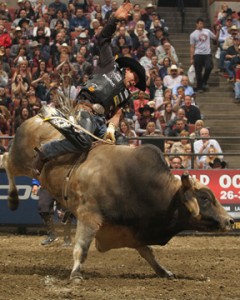Bull Market in Anaheim
By Victor J. Otten February 1, 2011
Silvano Alves rides D&H's Hot Stuff for first place at the Anaheim Invitational. (Photo by Andy Watson)
Spectators showed up in droves for the Anaheim Invitational, the third event in the “Built Ford Tough Bull Riding Series,” nearly filling the Honda Center, Jan. 21–22. Silvano Alves took top honors in the championship round on a bull named Hawaiian Ivory, and had the highest point average for the four rounds: 946.25, with total winnings of $39,225.
Skeeter Kingsolver came in a close second with 951 points and $23,350 earned. In terms of total points accrued, the field fell fast after that, with Guilherme Marchi coming in third with 596.50 and $12,400.
The Invitational took place in the middle of Orange County—land of skaters, water polo and punk rock—but it felt like Texas. Were these people decked out in black Stetson hats and jeans real bull-riding fans, or just here to see some earnest young cowboy get the heck stomped out of him?
I grew up surfing the beaches of Southern California. My brother was an amateur bull rider. Not knowing anything about the sport, I thought it was totally ridiculous. After all, we were born in the City and were not cowboys. He and his bull-riding buddies would hang out wearing cowboy hats and Wrangler jeans and chewing tobacco.
About 20 years later a friend showed me a video of a bull named Bodacious. Some say that Bodacious was the greatest bucking bull ever. His athletic ability was freakish—at 1,800 pounds, that bull could spin, dive and buck so fast that few people could ride him. He was also the kind of bull that was going to make you pay the price for even trying—it’s my understanding that only seven people rode him for eight seconds.
Bodacious seriously injured some of the best bull riders in the nation. Former three-time world bull riding champion Tuff Hedeman had to undergo reconstructive surgery after striking his face on the bull’s head. Another professional bull rider tried riding Bodacious while wearing a face mask, but the bull head-butted him, breaking his nose and busting an eye socket.
Who in their right mind would strap themselves to a 1,500-pound Angus rocket, knowing that it is just a matter of time before they land in a hospital? For the vast majority of bull riders, there is no money in the sport, and injury is a certainty. What are these kids thinking?
The Professional Bull Riding (PBR), Inc. Web site states that blood, bruises and broken bones are all part of a day’s work. Protecting the riders is a team of rodeo clowns and medical personnel. There is always an ambulance at the ready, to transport injured riders to the hospital, while a veterinary team stands by to tend injured beasts.
The bull riders are tough. At this event, Robson Palermo was riding with a broken right ankle and Renato Nunes was competing with an injured right wrist—after a two-year recovery from a broken back. Why do they do it? A professional bull rider once told me, “When you climb on a bull’s back and signal to have the chute open, you are totally living in the moment. It is really scary. There is no bigger adrenaline rush anywhere.”
The bulls themselves are fantastic creatures—huge, beautiful animals with great athletic ability and individual personalities. Some of the bulls seem to want a pound of flesh and chase the riders after bucking them off, while others will simply run back into the holding area. My favorite bull at the Anaheim event was Bushwacker, whose average buck-off time is 2.84 seconds. J.B. Mauney picked Bushwacker in the Championship Round and got bucked out of the money.
The finals got off to a rough start when veteran Beau Hill got injured on a cantankerous bull named Best Ever. Hill left the premises in an ambulance. Moments later, McKennon Wimberly took a horrific wreck on a bull named Moe Bandy. I was sitting in the front row, close to where Moe gave Wimberly a beating he won’t soon forget. Wimberly’s helmet was knocked off by Moe, and his head struck a horn. Wimberly went down hard and lay prone on the arena floor. The medical team eventually took him out on a stretcher and put him in an ambulance. As there were no additional ambulances, the show had to be put on hold.
One can only imagine what was going through the remaining riders’ minds. Stormy Wing, a young man from Texas, was the first to follow the wrecks on a bull named Pit Boss. He ended up in fourth place overall.
Short URL: https://theequestriannews.com/?p=128




